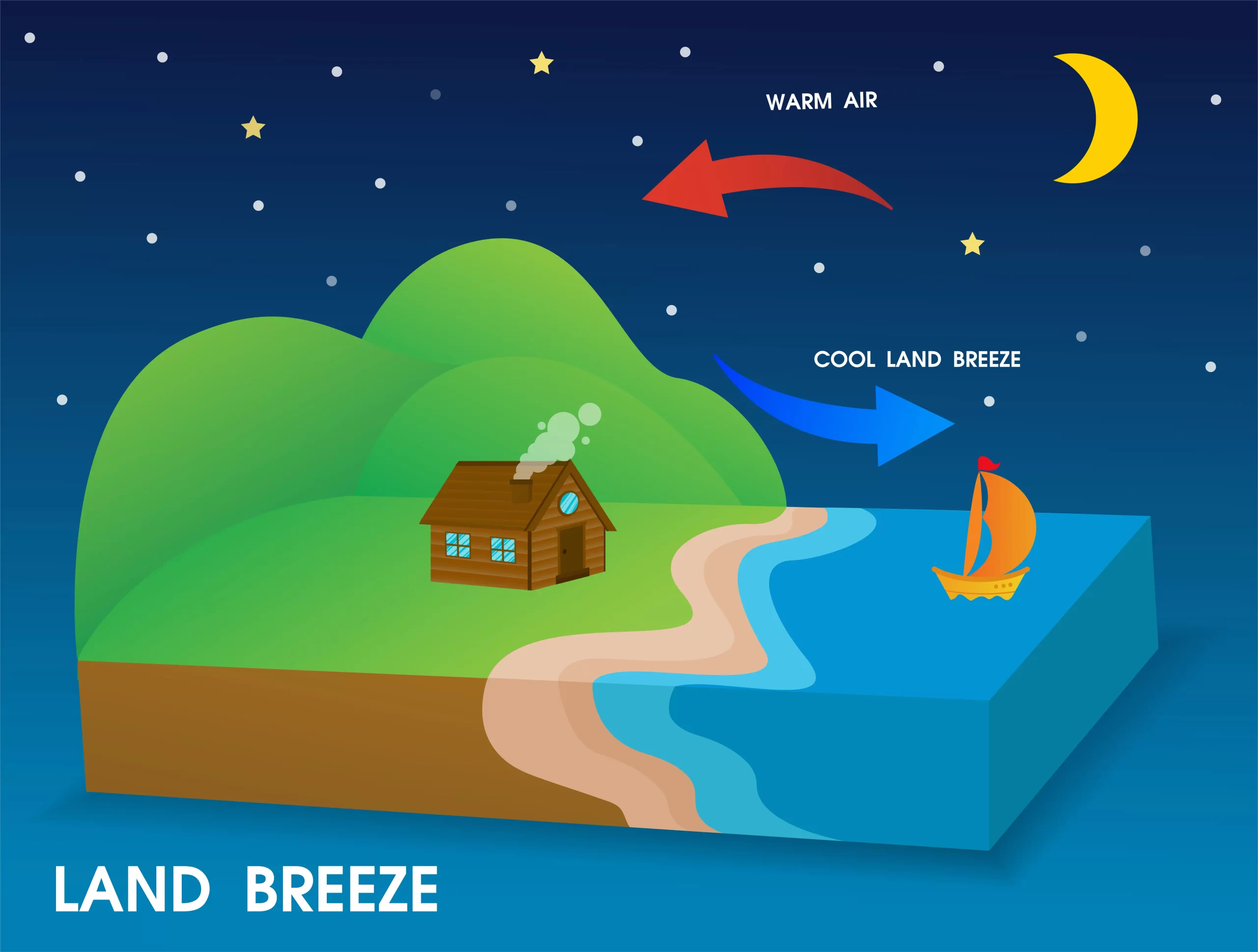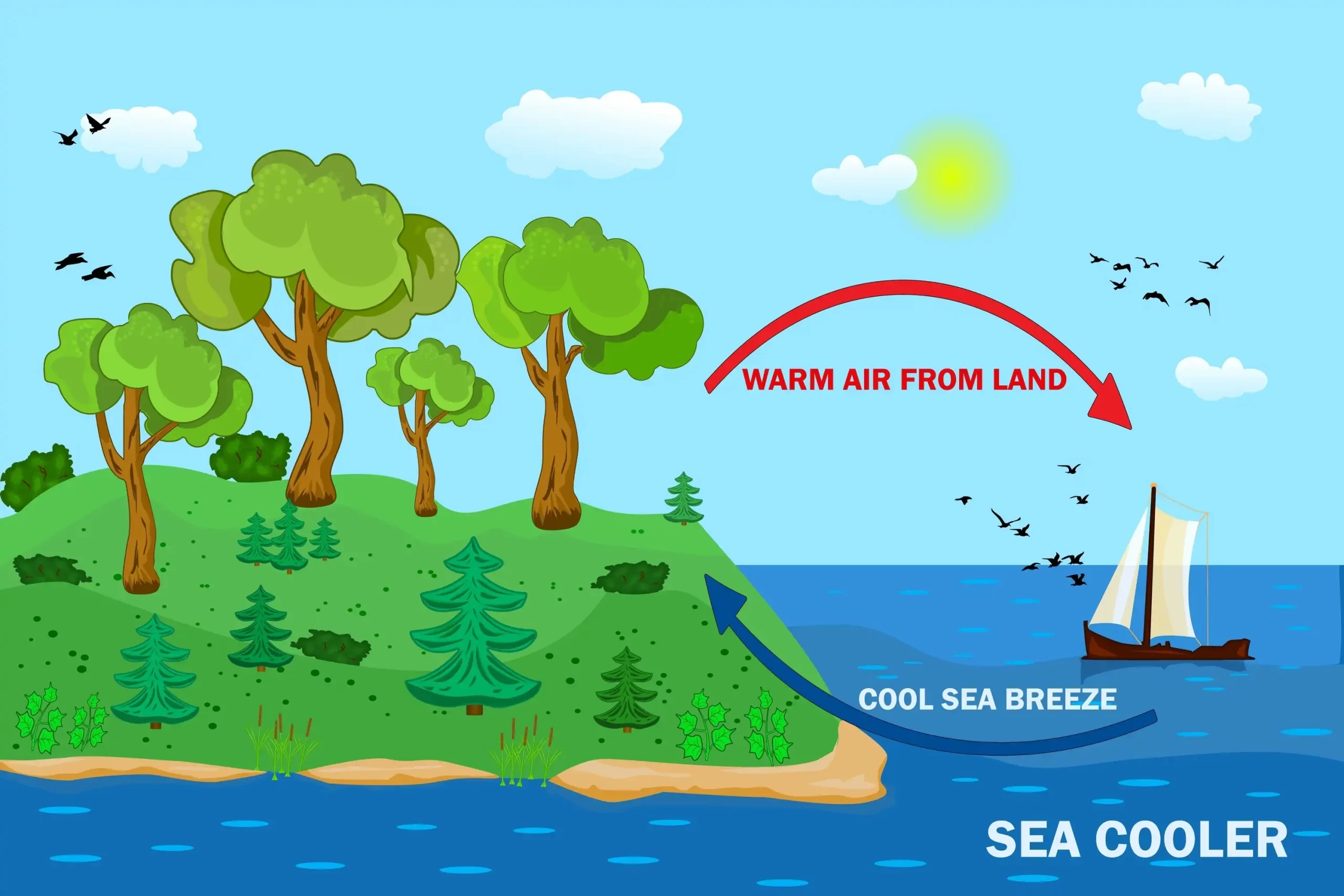Introduction
The Earth is the only planet in the solar system to support life and a major reason behind that is the air on this planet. Air is a mixture of gasses that surrounds the earth and contains oxygen, which is necessary for breathing. This blanket of air also acts as a protective shield against harmful radiation from outer space. Due to the presence of air and the force of gravity, there is a pressure of air all around us that is known as atmospheric pressure. It varies directly with height and is measured using a barometer. Differences in pressure lead to the flow of air and this leads to various weather phenomena.
What is a land breeze?
A land breeze is also called an offshore wind and occurs when wind blows from the land towards the sea. This process continues throughout the night and is reversed during the day. When the sun sets in the evening, the land cools down faster than the water, causing the air above it to cool down as well. However, the air above large water bodies doesn’t cool down as fast and thus, rises up, causing a low pressure zone. Due to this pressure difference, air starts moving towards the water, creating a land breeze.

Land breeze
What is a sea breeze?
When wind blows from the sea towards the land, it is known as a sea breeze or onshore breeze. This typically occurs during the daytime when the sun heats up the land more quickly than the water, causing the air above the land to warm up and rise. As a result, there is low pressure over the land. The air above the water, which is cooler, has a higher density, leading to high pressure. The pressure difference causes the air to move from the high-pressure area over the water to the low-pressure area over the land, creating the sea breeze.

Sea breeze
Facts about the land and sea breeze
Land Breeze Formation
- Land cools down faster at night while water bodies retain heat for a longer period of time.
- The higher temperature causes a low temperature zone above the water as compared to the area above land.
- Hence, air starts flowing towards the sea, giving rise to the land breeze.
Sea breeze formation
- During the day, the presence of sunlight heats up the land, causing the air above it to heat up and rise.
- Water bodies don’t heat up as fast and thus, the land becomes a low pressure zone.
- This creates a flow of air from the sea towards the land, known as a sea breeze.
Difference between land and sea breeze
While both land and sea breeze are most evident in coastal areas and affect weather conditions across an area of 32-50 km, they also carry some differences. These are tabulated below:

Summary
This article discussed how land and sea breeze are generated owing to the difference in temperatures and pressure over land and sea during night and day. It also listed a few salient points about the two and tabulated the differences between them. For better understanding, illustrative diagrams were also shown.
Frequently asked questions
1. What are atmospheric disturbances?
Atmospheric disturbances are temporary disturbances in the atmosphere of the earth that move from place to place. Depending on their strength, they can cause a drastic change in weather conditions even in a short period. Some examples include cyclones, hurricanes, and tornadoes.
2. What is a cyclone?
A cyclone is a swirling mass of air or wind that rotates either in clockwise or anticlockwise direction, depending on whether one is in the northern or the southern hemisphere. The center of the cyclone is at low pressure while the rotating portion is at a very high pressure.
3. What is the Coriolis effect?
Coriolis effect is a phenomenon that occurs due to the rotation of the Earth. It causes objects to appear to move in a curved path rather than a straight line when viewed from a rotating frame of reference. In the Northern Hemisphere, objects tend to curve to the right, while in the Southern Hemisphere, objects tend to curve to the left
4. What is wind?
Wind is simply the phenomenon of flow of air on Earth. Any type of movement of air is known as wind but depending on strength, wind can be a gentle breeze or a terrible tornado.
5. What are the effects of the Land breeze and sea breeze?
Land breeze leads to:
- Formation of fog above the sea.
- The heating of land at night.
- High humidity over the sea and dry conditions over the land
Sea breeze leads to:
- Early morning rainfalls.
- Humidity over the land.
- Clouds and fog over the land.
 Mission Statement
Mission Statement
“Empower every student to achieve full potential”
88Guru has been established with the social objective of making quality video-based learning material available to all Indian students. Technology, Connectivity and Social Media are rapidly changing the world of Education and we wish to lead the transformation of the tuition industry in India.
88Guru is the perfect complement to the current tuition model. 88Guru creates a wonderful opportunity for children and parents to bond while engaging in a valuable learning activity. It also provides the complete curriculum at your fingertips for those moments when you need some help at short notice. We believe that this mode of tuition could be transformational, adding hours to a child's day while providing complete control over the learning process.
Every course is taught by the best teachers from India's top schools and conducted in an engaging manner to keep students involved. The e-learning process consists of video-based instructions, computer-graded assignments, and a dashboard which allows the student and parent to track progress.


